Future
What’s new and next in exploring the future?
The next decade will be defined not by incremental progress but by seismic shifts in how the world works. Megatrends aren’t background noise; they’re the blueprint for what’s next. From AI to aging populations, climate collapse to geopolitical fracture, companies that thrive will be those that reinvent themselves in response to the tectonic forces reshaping society.
In a world of relentless disruption, business leaders need more than strategy, they need a megatrend mindset.
That means looking forward, not back. It means anticipating the seismic shifts reshaping our economies, societies, and technologies, and acting before others do. Leaders must use them to galvanise their organisations, mobilise talent, and reimagine what their business is for. Reinvention can no longer be occasional or reactive, it must become a core capability, a cultural instinct, a superpower.
The future won’t wait. The companies that lead it will be those bold enough to shape it.
So, what is driving the future, and how can you be part of it?
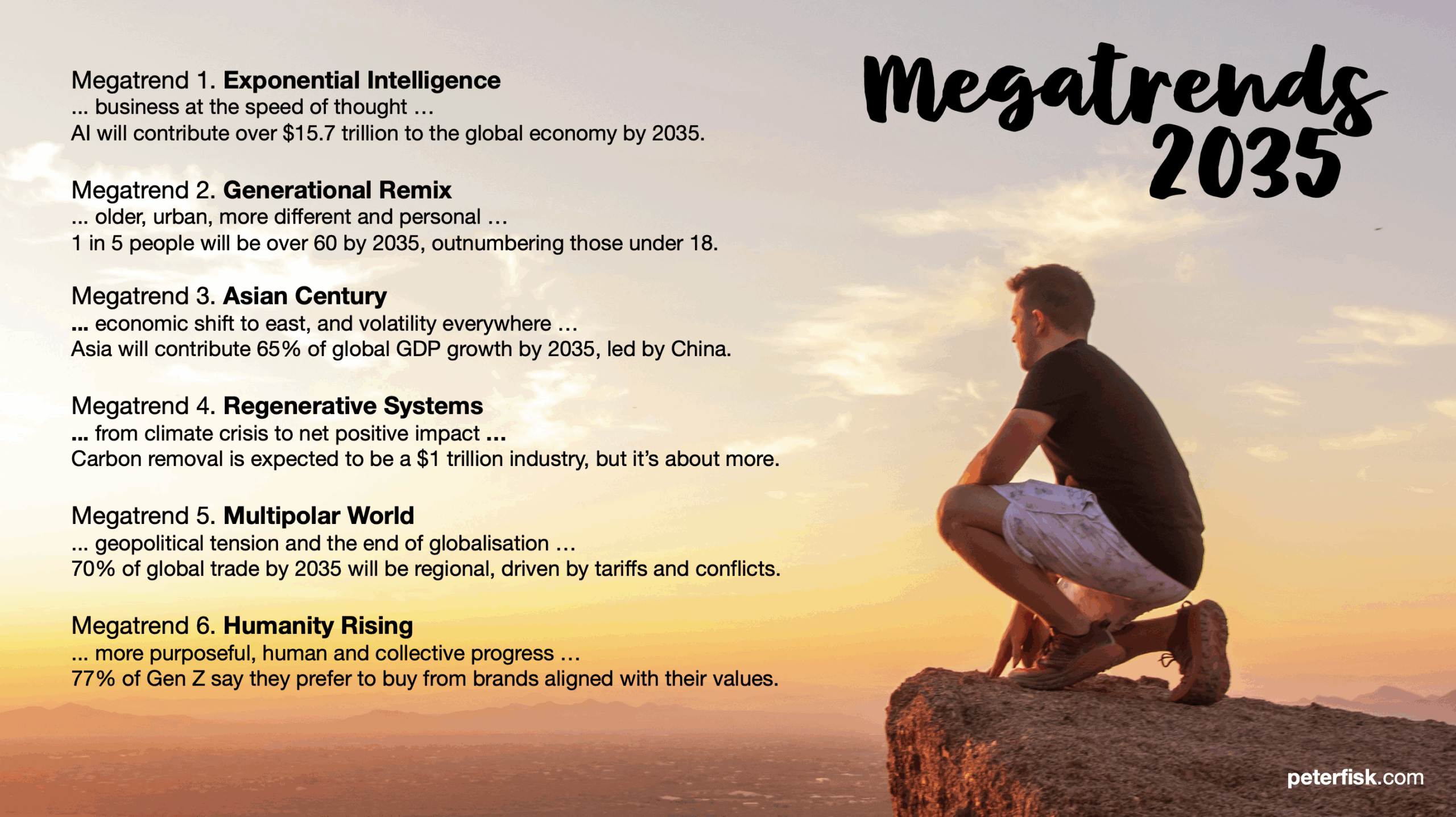
- Download the new report “Megatrends 2035″ by Peter Fisk
Megatrends are long-term, transformative forces that are global in scope, cross-industry in impact, and inevitable in their trajectory. From climate change and technological convergence to demographic shifts and urbanization, megatrends are not just fleeting headlines—they are the undercurrents shaping the future of markets, societies, and business itself.
Ignoring megatrends is no longer an option. They influence how people live, what they value, how they consume, how they work, and how economies evolve. For businesses, this means rethinking what they offer, how they operate, and why they exist. Companies that spot these shifts early and act boldly are the ones that leapfrog competitors, shape new markets, and earn the right to lead.
We explore six megatrends with a 10-year perspective, already shaking up every market. They are the disruptive forces that threaten your existence, but equally your biggest opportunities, superhighways to future possibilities, driving innovation and growth. And then we consider what they mean for your industry. How will they drive reinvention? What are the critical actions for business leaders, and the broader mindset to adopt? And who can we learn from?
Ultimately, the question is what will you do as a business leader – now – to create a better tomorrow, to shape the future that you want, and in which your business can thrive.

Megatrend 1. Exponential Intelligence … business at the speed of thought
By 2035, AI will be embedded in every business process. Intelligent systems will generate over 90% of digital content.
The line between human and machine thinking will blur. Exponential Intelligence represents the rapid acceleration of AI, and the convergence of technologies – in particular genomics, robotics, blockchains and energy storage – and new capabilities such as quantum computing.
AI’s application are profound, from accelerating new personalised medicines to fighting climate change, and new business models that deliver hyper personalisation.
This megatrend signifies a shift from linear progress to exponential possibility, where machines increasingly augment human decisions, also enabling people to add value in new ways. In the future AI will not just support businesses, it will co-create with them.
Companies must embed AI across every core function, from operations to marketing to finance, and develop proprietary models tailored to their domain. Leading firms are reimagining customer experiences through predictive, hyperpersonalised interfaces and training their workforces for human-machine collaboration.
Why does it matter?
- AI will contribute over $15.7 trillion to the global economy by 2035 (PwC).
- 90% of online content is projected to be AI-generated by 2026 (IBM).
- Over 40% of all jobs will be impacted by AI and automation (WEF)
What do we need to do?
- Apply AI models to core business activities to radically transform speed and costs, analysis and development
- Predict and personalise user interfaces to anticipate customer needs and serve them better and faster
- Build ecosystem business models to unlock mutual capabilities that capture the best new opportunities for growth.
Who’s doing it?
- Insilico Medicine: using AI to reinvent the process of drug discovery, development and evaluation, 10 times faster, 100 times cheaper
- Siemens: co-developing self-optimising autonomous factories using digital twins and AWS infrastructure
- Duolingo: Language learning reimagined with GPT-powered conversational roleplay, adapting instantly to user fluency and goals.
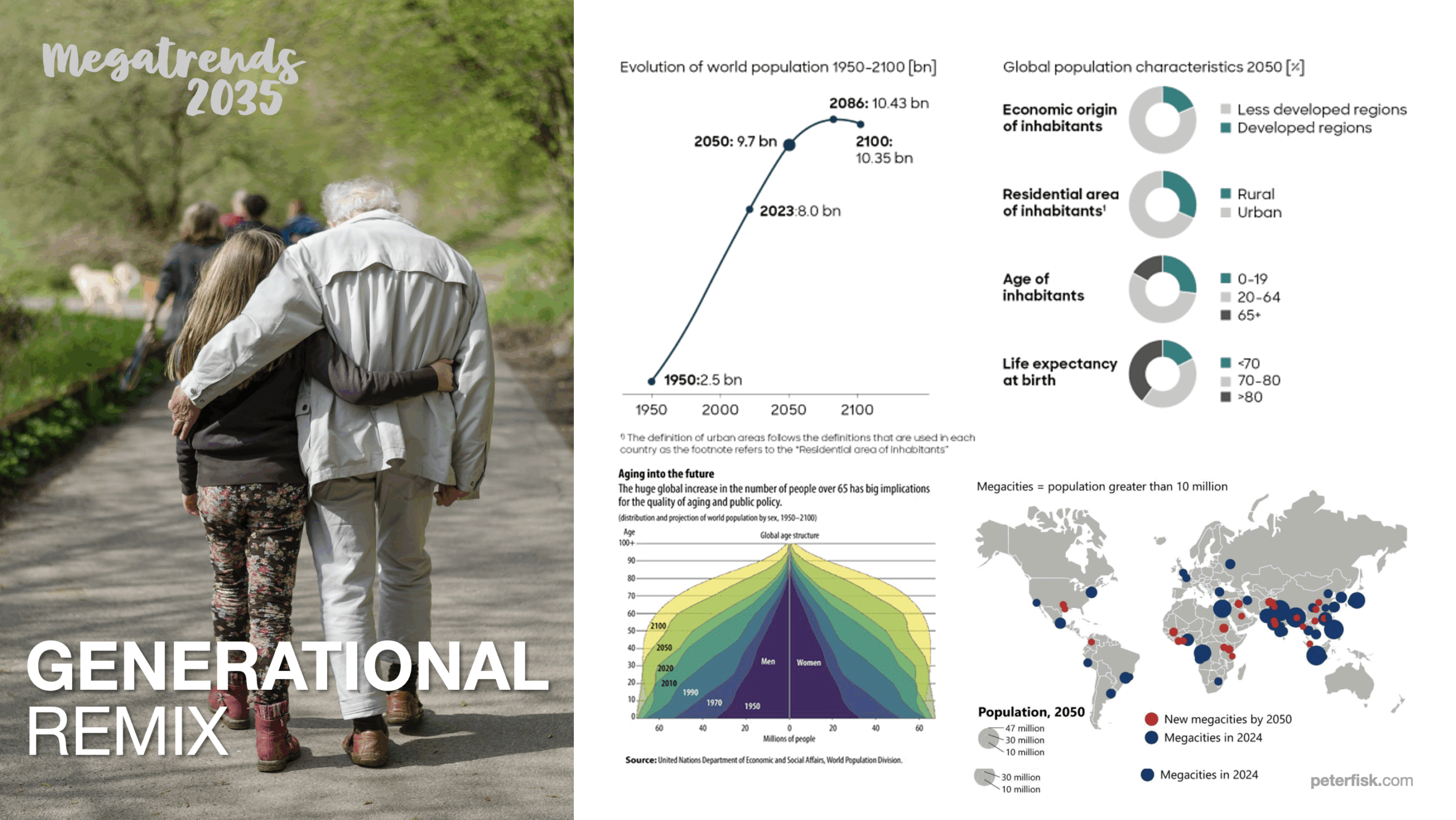
Megatrend 2. Generational Remix … older, urban, more different and personal
By 2035, society will be older, more urban, more different and personal — and yet also more connected than ever. Businesses must design for diversity, longevity, and identity.
Generational Remix captures the profound social transformation underway: populations are aging rapidly, cities are expanding, and cultural identities are becoming more diverse, fluid, and personal.
This megatrend is about designing for complexity and individuality – where different generations, values, and needs collide and co-create. It also drives fundamentally different support – older people are living longer with more affluence, for leisure and travel. Pensions will need to last longer, and healthcare costs will inevitably rise. Similarly urbanisation drives the reinvention of many services, from education and entertainment to how communities are built, and the rising power of city states.
Businesses must develop inclusive, intergenerational products and services; personalise offerings based on lifestyle rather than age; and embrace cultural plurality in design and communication. Planners must design cities, homes, and brands for 100-year lives, build inclusive, multigenerational workplaces, and address loneliness, mental health, and community. It is also about embedding cultural and demographic diversity into R&D. This is about treating every customer—and employee—not as a demographic, but as a unique human.
Why does it matter?
- 20% of global population will be over 60 by 2035, more than under 18
- 68% of the world will live in cities by 2035, and more in single homes
- 90% of global population growth to 2050 will be in Africa and Asia (UN)
What do we need to do?
- Develop intergenerational products and services, personalise offerings based on lifestyle and diverse identities
- Urban planning to design cities, homes, and brands for 100-year lives, build inclusive, multigenerational workplaces
- Reinvent urban services, from education and entertainment to how communities are built, and the rising power of city states.
Who’s doing it?
- Philips HealthSuite: Cloud-based health platform for remote care, chronic condition monitoring, and aging-in-place solutions.
- Nestlé Health Science: Investing in personalised nutrition, gut health, and senior wellness—especially in fast-aging markets.
- Toyota Woven City: A prototype smart city in Japan designed for autonomous vehicles, robotic assistance, and aging-friendly living.
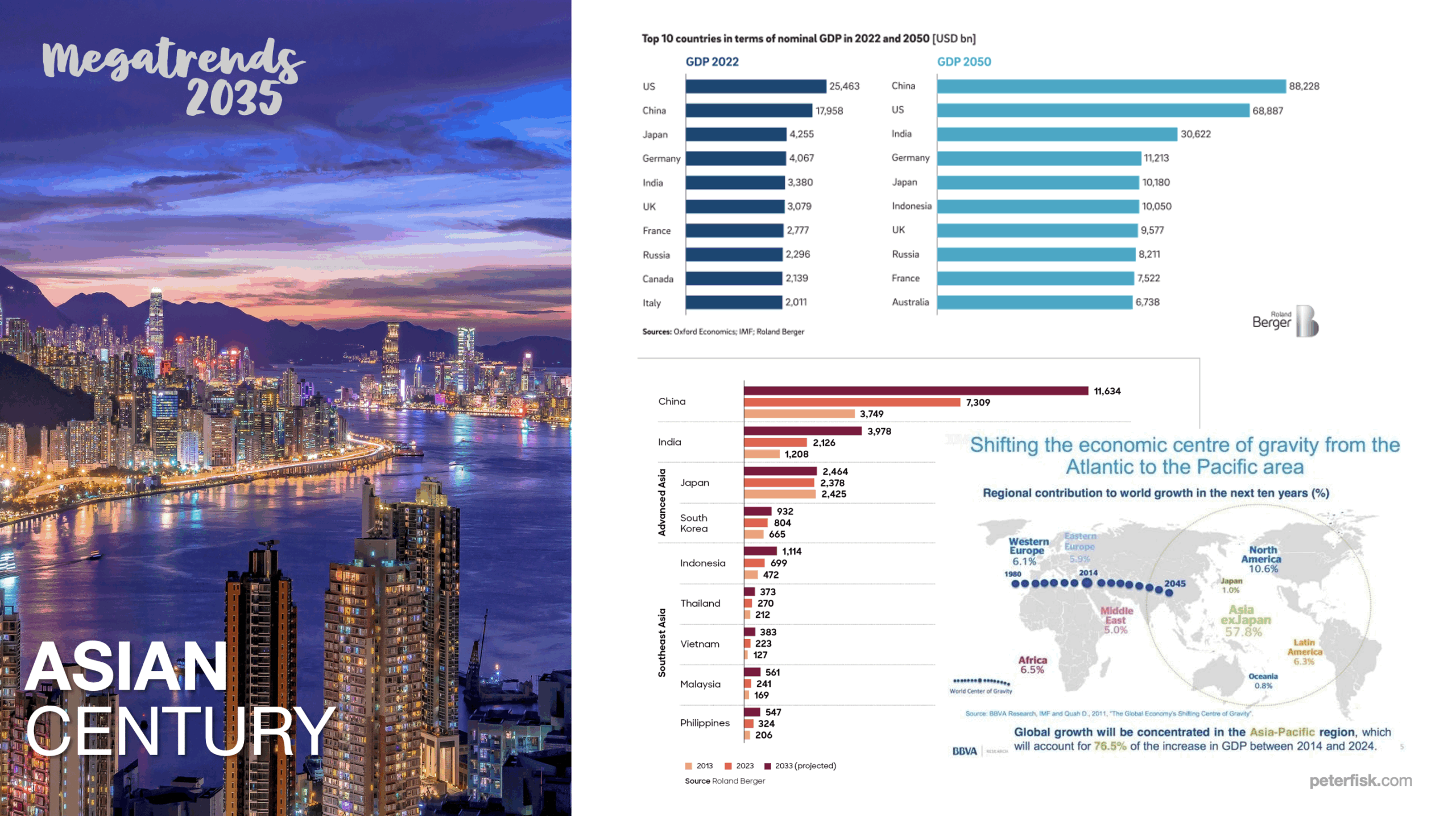
Megatrend 3. Asian Century … economic shift to the east, and volatility everywhere
Asia is the gravitational centre of global growth. By 2035, most middle-class consumers will live in Asia. The region will lead in innovation, consumption, and complexity.
The Asian Century represents the rebalancing of global economic power towards Asia and the Global South. These regions are not just growth markets—they are innovation hubs, cultural trendsetters, and geopolitical forces reshaping the future.
While Asia’s huge population with increasing disposable income will increasingly dominate the world’s consumer markets, Asia’s businesses have also dramatically shifted from cheap imitators of western goods, to leaping ahead in their application of new technologies, new business models, and innovations.
Businesses must do more than export to Asia—they must co-create in and for Asia, localising products for fast-rising middle classes in Tier 2/3 cities, collaborating with Asian startups, and embedding cultural relevance into innovation. India, Vietnam, Indonesia are popular locations for global R&D hubs. New digital trade corridors (eg RCEP, BRICS+ alliances) are reconfiguring markets. Superapps like Jio and Grab provide easy access to markets, through collaboration with their ecosystems. But with growth, prepare for volatility.
Why does it matter?
- Asia will contribute 65% of global GDP growth by 2035 (IMF)
- Over 50% of global consumer spending will be Asian by then.
- 83% of global AI-related patents are filed by Asian companies (Wired)
What do we need to do?
- Seize the Asian market opportunity, finding effective ways to access and compete eg Indonesia, Vietnam, tier 2/3 cities, BRIC trade corridor
- Localise and co-create with local partners, finding cultural relevance and sourcing and manufacturing locally.
- Learn from the best Asian companies, who have leapfrogged the west, and are typically the most innovative, agile and efficient in the world.
Who’s doing it?
- BYD: China’s batteries to EV giant has become the global leader, and in clean energy too
- Xiaomi: Creating consumer electronic products equal or superior to western peers but 90% cheaper
- LVMH Asia Studios: Culturally attuned luxury innovation, where Asian consumer no longer want western goods
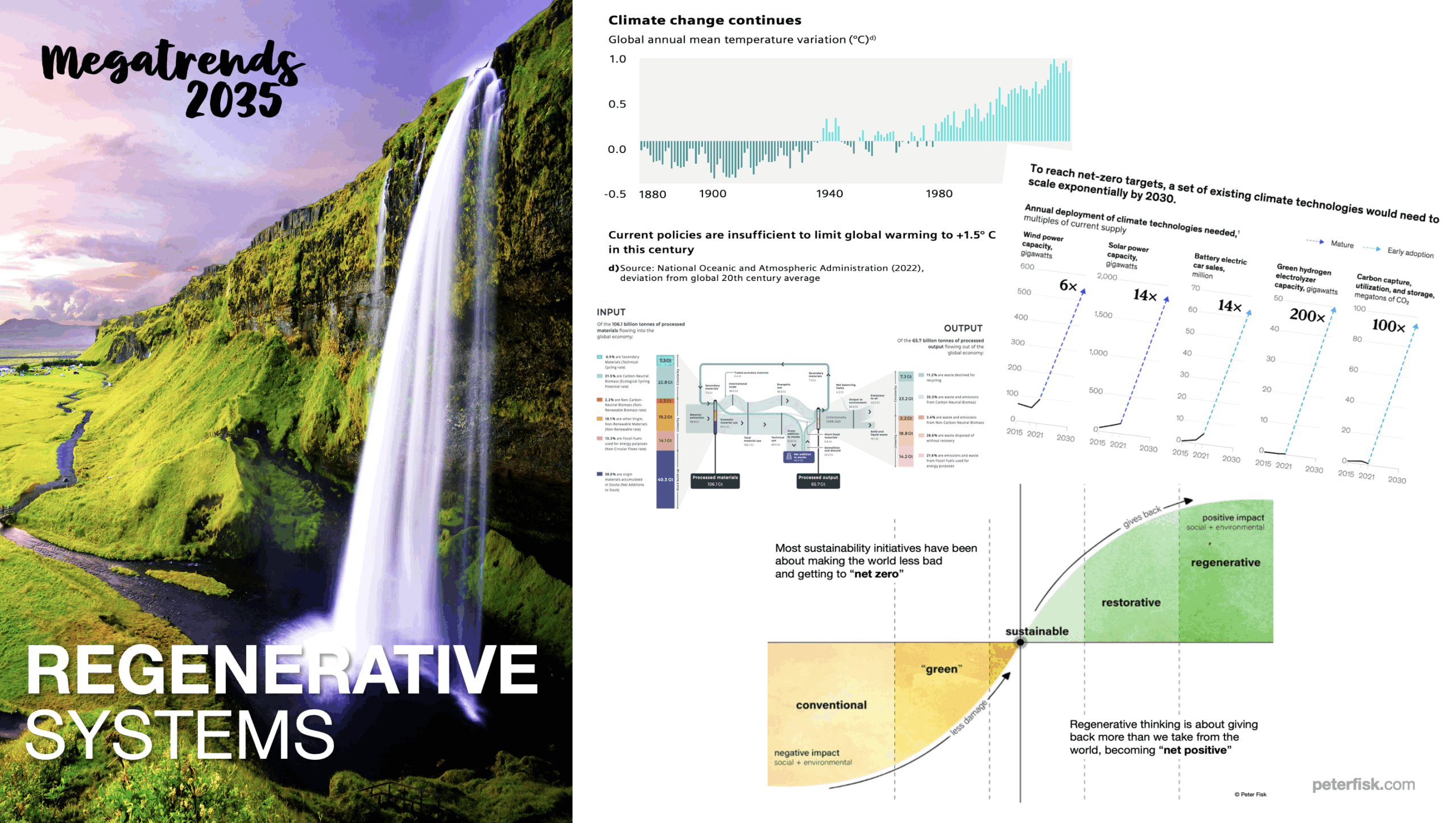
Megatrend 4. Regenerative Systems … from climate crisis to net positive impact
Climate change is the defining risk and opportunity of our time. But the frontrunners are moving beyond carbon-neutral to climate-positive and nature-regenerating models.
Regenerative Systems is about moving beyond sustainability as damage limitation toward a model that actively restores, replenishes, and reimagines the relationship between business and the planet. With the climate crisis accelerating and ecosystems under pressure, the regenerative economy is a shift from extractive to circular, from carbon-neutral to climate-positive.
The impact however can be even greater when we look beyond carbon – to other materials and resources – in particular, water and biodiversity. It can be greater still when we embrace social and environmental issues together, as they are often systemically connected.
This is when businesses really can reinvent for net positive impact.
Businesses must transition from compliance to leadership—transforming supply chains into regenerative ecosystems, adopting circular design, and tying executive incentives to sustainability performance. This includes decarbonising supply chains with digital ESG tracking, linking executive pay to sustainability goals, restoring biodiversity and natural capital, and creating planet-positive products and services.
Why does it matter?
- The world’s business systems are still only 6.9% “circular” (IPCC)
- Clean energy will be 60% of the global energy mix by 2035 (IEA)
- Embedding the 17 SDGs is worth $12 trillion, and 380 million jobs (UN)
What do we need to do?
- Develop regenerative business models, going far beyond CSR and ESG, circular and net zero, to create net positive impact
- Think beyond carbon to embrace other challenges eg biodiversity, water, but also social issues eg equality, fairness, etc
- Focus innovation on the big problems, AI to address climate change and disease, to create 40% more food, 50% more energy, in new ways
Who’s doing it?
- Schneider Electric: Helping cities and factories go carbon-neutral through connected, AI-managed energy efficiency platforms.
- Interface: creating net-positive floor tiles that absorb carbon, creating the “factory as the forest”
- Nubank: world’s fastest growing bank from Brazil, targeting the unbanked, building financial literacy, reducing poverty, and building inclusion.
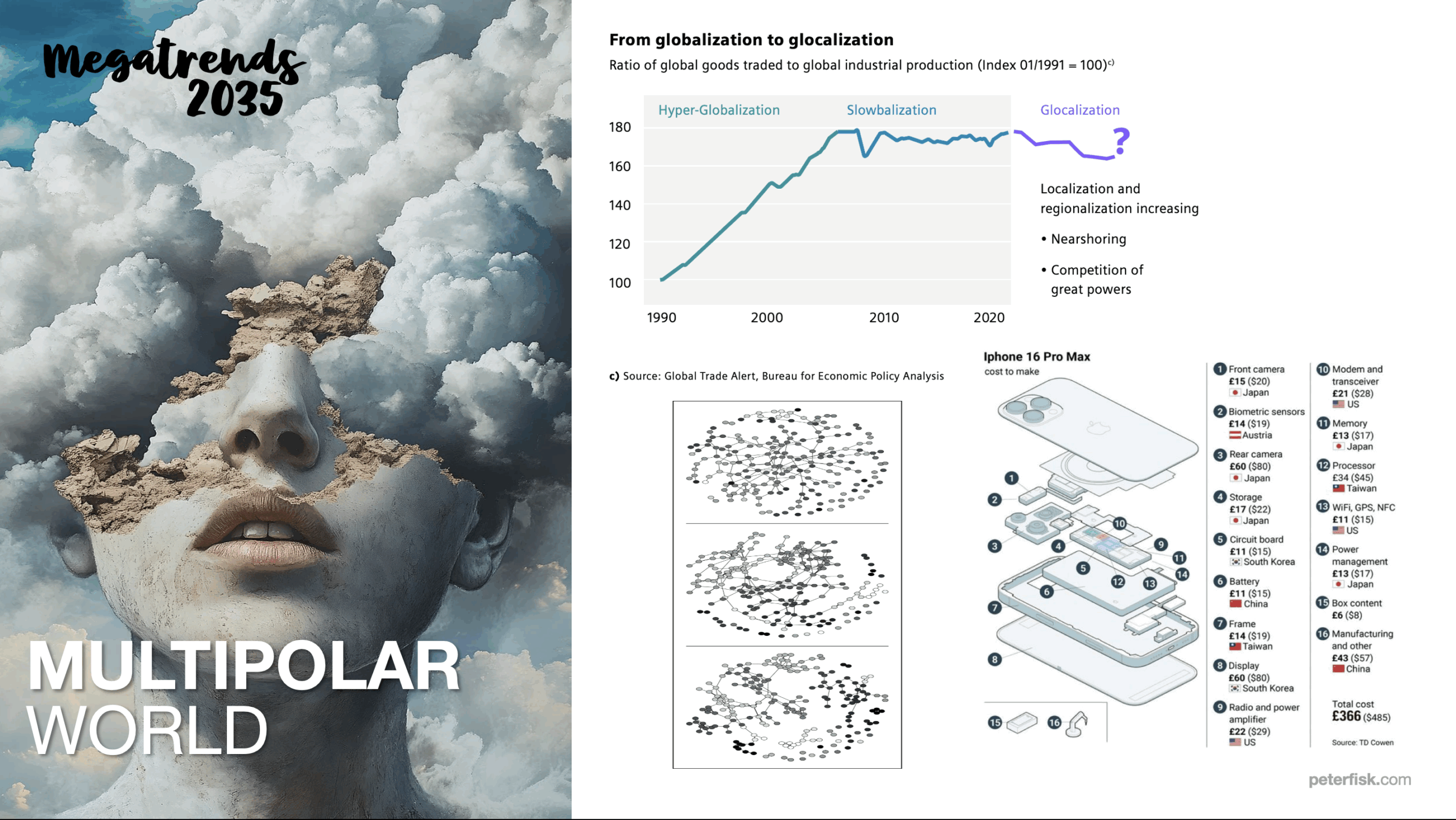
Megatrend 5. Multipolar World … geopolitical tension and the end of globalisation
The old model of seamless globalisation is fragmenting. Economic nationalism, digital sovereignty, and supply chain shocks driven by conflicts and tariffs are reshaping business strategy.
Multipolarity marks the end of the unipolar, globalised world as we knew it. With growing geopolitical tensions, trade fragmentation, and inwards facing economic policies, companies are navigating a world of shifting alliances, digital borders, and regional blocs.
By 2035, over 70% of global trade will occur within regional networks. Data sovereignty regulations will be in place in dozens of countries, and supply chains will be redesigned for resilience, not just cost.
Businesses must nearshore manufacturing, create flexible, modular operations, and navigate complex trade relationships with agility and foresight. The reinvention challenge is to build resilience without retreat—balancing localisation with global ambition.
Why does it matter?
- Global trade as a % of global GDP has declined since 2008 (OECD)
- By 2035, over 70% of global trade will occur within regional networks
- 84% of global executives now rate geopolitical as their top risk (McKinsey)
What do we need to do?
- Redesign supply chains for resilience, agility not cost, nearshoring and partnering closer to customer markets,
- Diversify your global spread of markets and operations, to spread risk and be more responsive to change.
- Address data sovereignty, and other issues such as IP protection, regulation, cybersecurity, with foresight and influence.
Who’s doing it?
- Apple: Accelerating iPhone and chip production in India to diversify away from China, including flagship stores in Mumbai and Delhi.
- Inditex: Strengthening local production in Europe and the Americas to respond faster and reduce geopolitical exposure.
- Flexport: Creating tech tools to reroute and de-risk global supply chains in real-time amid fragmentation and shocks.
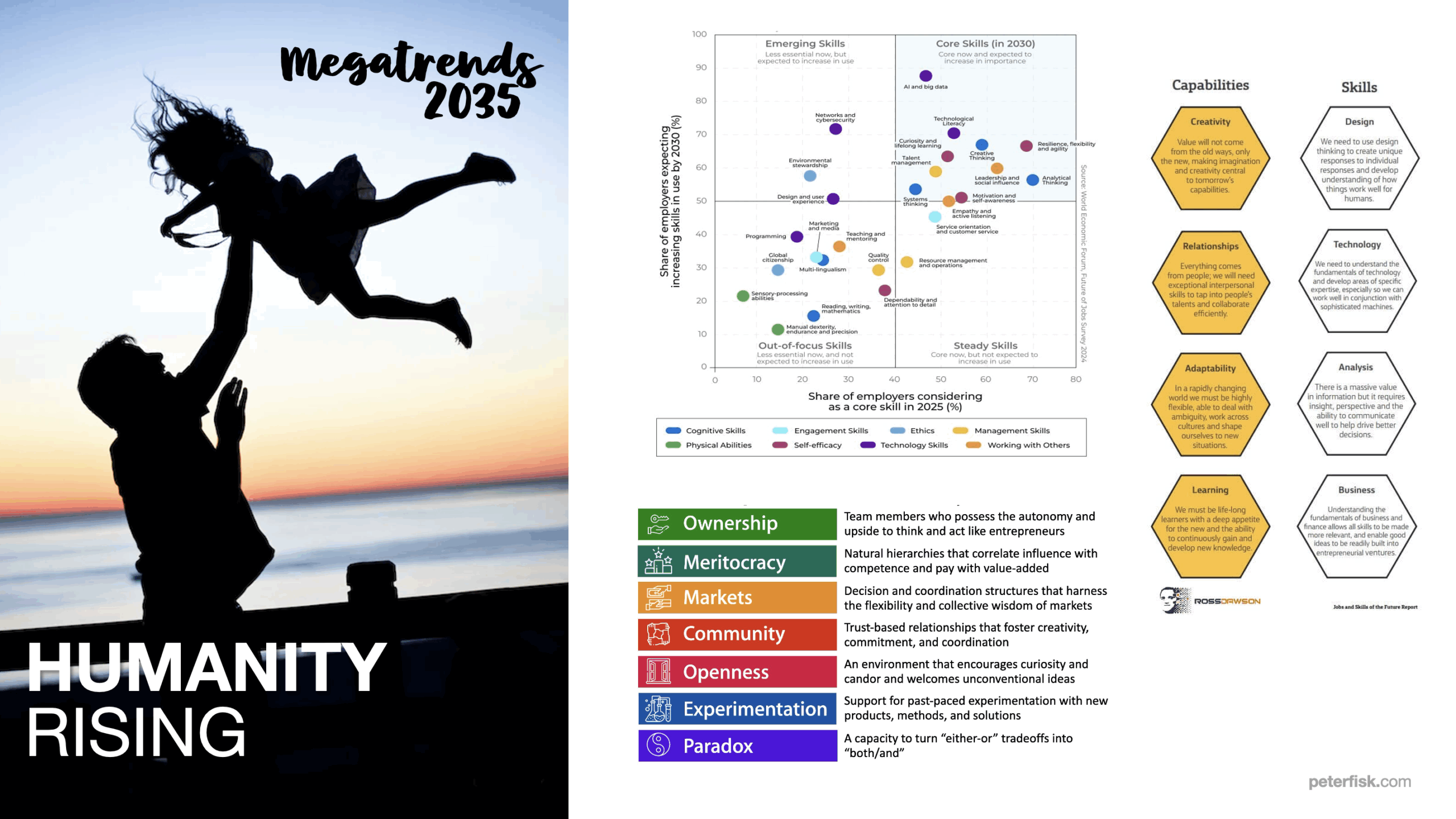
Megatrend 6. Humanity Rising … more purposeful, caring and collective progress
The most powerful force in business is the human one. Trust, wellbeing, meaning, and social contribution are now core to business strategy.
Humanity Rising is a movement toward putting people and purpose at the heart of business. It reflects a shift from transactional to meaningful work, from shareholder primacy to stakeholder ecosystems, and from short-term profit to long-term wellbeing.
As automation, and specifically AI, takes on the repetitive tasks of many workflows, business need to redesign human roles for more added value.
Companies must rewire culture around empathy, trust, and meaning; invest in human-centred leadership; and design work for life, not just productivity.
By 2035, businesses that lead on purpose and wellbeing will significantly outperform their peers. Mental health will be a core performance metric, and the human experience of work—flexibility, autonomy, growth—will shape loyalty and innovation.
Humanocracy calls for ”organisations as amazing as the people inside them”. Microsoft’s Satya Nadella recognised this calling for his organisation to be a platform to showcase each person’s unique talents, to let them achieve their ambitions, rather than just being the cog in the works of a corporate machine.
Why does it matter?
- Purpose-driven brands grow 2.5x faster than average brands (WARC)
- 77% of GenZ seek meaningful work, and buy meaningful brands (McKinsey)
- AI augmentation is likely to improve human productivity by 40% by 2035
What do we need to do?
- Create purposeful business strategies, that turn purpose into real action and delivers better progress – profitable growth and positive impact.
- Redesign for human added value so that technology automates processes, releasing people to achieve more
- Build organisations as amazing as the people inside them: empowering, democratic, enabling, caring, dynamic, resilient and daring.
Who’s doing it?
- Danone: Legally binding mission-driven governance (B Corp), in its shift from food to becoming a health business
- Salesforce: Flexibility, purpose, ethics as a platform, mental health through “Success from Anywhere” strategy
- Mindera: Portuguese software “made by humans” … people-first culture fostering innovation through community, autonomy, and trust.

How megatrends drive business reinvention
Every industry is being reinvented.
These 6 megatrends create a perfect storm of technological breakthroughs, shifting consumer expectations, environmental imperatives, and economic uncertainty that are driving radical transformation across every sector. The boundaries between industries are blurring, value is migrating to new models and ecosystems, and the winners of tomorrow are being shaped today.
From automotive to insurance, banking to retail, energy to healthcare, established players face existential pressure to change. Legacy systems, slow-moving cultures, and risk-averse mindsets are being outpaced by fast, bold innovators—companies that use data, AI, and platform thinking to deliver better, smarter, more sustainable solutions. Tesla isn’t just a car company. Amazon isn’t just a retailer. They’re both operating systems for the future.
Disruptors are emerging from every corner of the globe—scaling faster, experimenting more aggressively, and harnessing the power of technology to solve meaningful problems.
These next generation leaders are obsessed with what’s next. They blend purpose and profit, long-term impact and short-term agility. But incumbents aren’t out of the race. The most forward-looking are reinventing themselves, acquiring new capabilities, and unlocking value from their intangible assets—brand, trust, ecosystems, and intelligence.
The next five years will be decisive. Growth will come not from doing more of the same, but from reimagining what’s possible—through smart automation, regenerative design, AI-powered personalization, and bold new business models. The winners will be those who stretch their vision, embrace uncertainty, and build for the future—not the past.
Reinventing Automotive
When Lei Jun unveiled the SU7 electric supercar from his smartphone maker Xiaomi, with comparable features but over 90% cheaper than a Porsche Taycan, we knew the industry was not just being disrupted, but fundamentally reinvented. No longer just about horsepower and design, the future of cars became about software, autonomy, and energy ecosystems. Disruptors like Tesla, BYD, and Rivian are redefining mobility, while incumbents like GM and VW scramble to catch up. The future belongs to firms that can merge electric drivetrains with data-driven intelligence, build direct customer relationships, and plug into renewable grids.
- Key Drivers: EV revolution, autonomy, mobility-as-a-service
- Disruptors: Tesla, BYD, Rivian, Waymo, Nio, Xiaomi
- Incumbents: VW and Hyundai invest heavily in EVs and batteries; GM pivots toward all-electric by 2035
- Future Winners: Tesla remains dominant due to its integrated energy + mobility model; Chinese EV players like BYD are poised to lead on affordability and scale; Apple and Sony may emerge through software-first approaches
- Growth Areas: EVs, autonomous fleets, in-car software, subscription mobility
- Outlook: $5T transformation underway; platforms and ecosystems will define winners
Reinventing Banking
In Brazil, David Vélez launched Nubank to free people from bureaucratic, fee-heavy traditional banks. With nothing more than a smartphone and a smile, customers signed up for accounts in minutes. Nubank now serves over 90 million users. Fintechs are rewriting the rules with embedded finance, AI risk models, and crypto rails. Traditional banks must become platforms, not fortresses. Future leaders will be those who turn trust, data, and user experience into intelligent financial ecosystems.
- Key Drivers: Fintech, AI, blockchain, real-time services
- Disruptors: Nubank, Revolut, Stripe, Square, DeFi
- Incumbents: JPMorgan and DBS investing in AI, APIs, and sustainability-linked finance
- Future Winners: Digital-first, customer-centric, embedded finance providers that turn financial services into frictionless tools
- Growth Areas: AI-enabled wealth tools, crypto custody, sustainable lending
- Outlook: Banking becomes invisible, embedded in lifestyle
Reinventing Construction
Using 3D printing, Icon built a house in 24 hours using a giant robotic arm and a special concrete blend—radically reducing time, cost, and environmental impact. This illustrates the kind of breakthrough needed in a notoriously slow-moving industry. Innovation now means modular, smart, and zero-carbon construction. Giants like Skanska are investing in digital twins and low-carbon cement. Winners will combine automation, green design, and tech-savvy talent to transform how we build the future.
- Key Drivers: Green buildings, modular methods, robotics
- Disruptors: Icon (3D printing), Katerra (prefab), CarbonCure (CO2 tech)
- Incumbents: Skanska, Bouygues, Holcim, and Turner adopting digital twins and zero-carbon materials
- Future Winners: Tech-integrated construction firms that deliver faster, cleaner, cheaper buildings; smart infrastructure providers
- Growth Areas: Smart cities, digital twins, sustainable housing
- Outlook: $1T green retrofit and smart build opportunity
Reinventing Energy
Octopus Energy is disrupting utilities by putting customers at the heart of a clean energy revolution—offering dynamic pricing, transparency, and rapid green energy switching. In an industry long dominated by giant incumbents, it proved agility can win. The transition to net zero, powered by solar, wind, hydrogen, and AI-managed grids, is accelerating. Winners will not just produce energy, but orchestrate energy flows, storage, and demand across intelligent, decentralised networks.
- Key Drivers: Decarbonization, decentralization, storage
- Disruptors: Tesla Energy, Octopus Energy, Vestas, Climeworks
- Incumbents: Shell, TotalEnergies, and BP redefining themselves as energy transition companies
- Future Winners: Companies that integrate solar, wind, storage, and smart grids into unified platforms
- Growth Areas: Renewables, green hydrogen, carbon capture, virtual power plants
- Outlook: Clean energy to dominate mix by 2030; trillion-dollar opportunity
Reinventing Entertainment
When Roblox went public, it revealed that kids were spending more time building and playing in virtual worlds than watching TV. Entertainment is no longer passive—it’s immersive, participatory, and social. New models powered by creators, fans, and algorithms are dominating, as traditional studios play catch-up. Netflix disrupted distribution; now AI and generative content are the new frontiers. Winners will build platforms that blend content, community, and co-creation.
- Key Drivers: Streaming, gaming, AI content, creator economy
- Disruptors: Netflix, Epic Games, Roblox, TikTok
- Incumbents: Disney+ reinvention; Warner Bros. bets on streaming + IP
- Future Winners: Firms that merge entertainment, social engagement, and immersive tech; those who own IP and fan relationships
- Growth Areas: AI-generated content, gamified storytelling, AR/VR
- Outlook: Creator platforms to become dominant media forces
Reinventing Fashion
Pangaia isn’t just a fashion brand—it’s a material science company using seaweed fibers and bacteria-based dyes to reinvent sustainable clothing. Fashion is being reshaped by digital identities, circular design, and transparent supply chains. Fast fashion disruptors like Shein use real-time data and micro-inventory, while luxury players are experimenting with resale and digital fashion. Future winners will merge purpose with personalization, creating garments that are smart, sustainable, and story-driven.
- Key Drivers: Sustainability, digital fashion, circularity
- Disruptors: Shein, ThredUp, Pangaia, DressX
- Incumbents: LVMH and Zara building closed-loop supply chains and digital experiences
- Future Winners: Brands that mix identity, impact, and innovation; digital-native and circular-first businesses
- Growth Areas: Resale, AI design, bio-materials, virtual clothing
- Outlook: Fashion shifts from volume to value, driven by tech + conscience
Reinventing Food and Drink
At NotCo, AI named Giuseppe creates plant-based versions of animal products by analyzing molecular similarities. It made mayo, milk, and meat that taste like the real thing—but aren’t. This signals a shift toward food as software: designed, personalized, and planetary. The food revolution is being driven by sustainability, health, and technology. Giants like Nestlé are investing in alt-proteins. Winners will feed the future with science, values, and delicious innovation.
- Key Drivers: Health, sustainability, transparency
- Disruptors: Beyond Meat, Oatly, NotCo, Upside Foods
- Incumbents: Nestlé and Unilever invest in plant-based and direct-to-consumer (DTC) platforms
- Future Winners: Brands that align with planetary and personal health; those who digitize the food chain
- Growth Areas: Alt protein, fermentation tech, personalized nutrition
- Outlook: $300B alt-protein industry by 2030; data becomes the key ingredient
Reinventing Healthcare
During the COVID-19 pandemic, BioNTech—once a little-known biotech firm—partnered with Pfizer to deliver a vaccine in record time using mRNA technology. It was a moonshot moment. Healthcare is being reinvented through genomics, AI, and patient-centric platforms. Startups like Tempus and Babylon offer predictive care and digital diagnoses, while incumbents digitize clinical pathways. Future leaders will move from treating illness to preventing it—personalized, predictive, and precision-driven.
- Key Drivers: AI, genomics, personalized medicine
- Disruptors: Tempus, BioNTech, 23andMe, Babylon Health
- Incumbents: Pfizer, Novartis and Roche embed AI across drug discovery and diagnostics
- Future Winners: Companies delivering preventive, digital, and personalized care at scale
- Growth Areas: AI drug discovery, wearable diagnostics, gene therapies
- Outlook: From reactive to proactive care; multi-trillion-dollar ecosystem
Reinventing Insurance
Lemonade turned heads by settling some claims in under 3 seconds, using AI and behavioral economics. It proved insurance doesn’t have to be slow, opaque, or distrusted. Climate volatility and shifting lifestyles demand real-time, proactive coverage. Incumbents like Munich Re are adapting with prevention-as-a-service. The winners will anticipate, not just insure—embedding risk reduction, AI insights, and customer trust into everything.
- Key Drivers: Risk prevention, personalization, AI pricing
- Disruptors: Lemonade, Zego, FloodFlash, Trōv
- Incumbents: AXA and Munich Re building smart risk platforms and climate resilience tools
- Future Winners: Insurers who evolve into risk-reduction partners powered by real-time data
- Growth Areas: Parametric insurance, embedded models, prevention-as-a-service
- Outlook: Reinvention from safety net to proactive value provider
Reinventing Manufacturing
Relativity Space is using 3D printing to make rockets—95% fewer parts, far faster iterations. It’s a symbol of manufacturing’s new age: flexible, intelligent, and software-defined. Automation, IoT, and AI are transforming everything from design to delivery. Legacy players like Siemens and GE are embracing digital twins. The factories of the future will be smart, sustainable, and continuously learning.
- Key Drivers: Industry 4.0, robotics, sustainability
- Disruptors: Relativity Space, Xometry, Vention
- Incumbents: Siemens, GE, and Bosch digitizing supply chains and factory floors
- Future Winners: Agile, hyper-automated, sustainable manufacturers with digital cores
- Growth Areas: Smart factories, additive manufacturing, nearshoring
- Outlook: $1T+ productivity gains from intelligent manufacturing
Reinventing Retail
Shopify gave small businesses global reach with a few clicks—and now powers millions of storefronts. Retail is shifting from stores to ecosystems, driven by social commerce, AI curation, and instant fulfillment. Amazon, Temu, and ThredUp are reshaping expectations. Incumbents must combine digital agility with deep human insight. The next winners will create seamless, personalized, and values-based retail experiences.
- Key Drivers: Omnichannel, AI personalization, circularity
- Disruptors: Amazon, Shopify, Temu, ThredUp
- Incumbents: Walmart and Target investing in AI, last-mile, experiential retail
- Future Winners: Ecosystem retailers blending physical, digital, and sustainable offerings
- Growth Areas: Social commerce, live shopping, AI recommendation engines
- Outlook: Retail = technology; brand trust + data + delivery = competitive edge
Reinventing Technology
When OpenAI released ChatGPT, it stunned the world—and ignited an AI arms race. Technology is the force multiplier of every transformation. AI, quantum, chips, and decentralised platforms are reshaping what’s possible. Disruptors like DeepMind and Anthropic push the frontiers, while incumbents like Microsoft integrate AI into everything. The winners will be ecosystem architects, building the foundations of a superintelligent, secure, and inclusive digital world.
- Key Drivers: AI, cloud, quantum, cybersecurity
- Disruptors: OpenAI, DeepMind, Anthropic, Nvidia
- Incumbents: Microsoft and Google integrating GenAI across platforms
- Future Winners: Platform-native firms owning data, chips, and AI layers
- Growth Areas: GenAI, autonomous agents, AI operating systems
- Outlook: Tech drives all other industries; $10T+ value shift imminent
Reinventing Telecoms
Starlink launched satellites fast enough to beam high-speed internet to war zones and remote villages alike. It showed how agile, hardware-software integrated telecom can leapfrog legacy infrastructure. With 5G, edge computing, and AI, telecom is evolving into a platform for everything—especially B2B. The leaders will connect not just people, but machines, data, and intelligence.
- Key Drivers: 5G, private networks, AI-managed ops
- Disruptors: Starlink, Rakuten Mobile, Helium Network
- Incumbents: AT&T, BT, and Orange reposition as digital service providers
- Future Winners: Providers offering integrated connectivity, intelligence, and cloud-edge infrastructure
- Growth Areas: Satellite internet, B2B 5G, telecom-as-a-platform
- Outlook: Telcos reinvent as enablers of digital society
Reinventing Travel
Airbnb changed not just where we stay—but how we experience the world. It made travel more local, personal, and flexible. Now, the rise of conscious travelers, nomadic workers, and immersive tech is redefining journeys. EcoHotels and digital nomad platforms are growing fast. Future winners will offer sustainable, seamless, and soul-nourishing travel—with data-driven personalisation and low-impact design.
- Key Drivers: Sustainable tourism, remote work, personalization
- Disruptors: Airbnb, Boom, Hopper, Nomadic, EcoHotels
- Incumbents: Marriott and Accor push eco-design, digital concierge, loyalty platforms
- Future Winners: Brands offering flexible, immersive, low-impact experiences
- Growth Areas: Bleisure (business + leisure), digital nomad services, green destinations
- Outlook: Travel reimagined around purpose, data, and experience.

Building a megatrend mindset
What the 6 megatrends share is a combination of inevitability and complexity.
They unfold over years, even decades, but their effects are accelerating. They create new winners and losers, and they require a mindset that is radically different from the one that dominated business in the past.
Traditional business thinking is rooted in linear assumptions, efficiency optimization, and incremental growth. But megatrends don’t follow linear rules. They interact with one another in unpredictable ways. They often create inflection points—sudden, nonlinear changes—that disrupt even the most well-defended industries.
Just consider how the fusion of mobile technology, social platforms, and AI enabled the rise of entirely new business models like Uber, and then TikTok which is as much about entertainment and shopping as networking. And over the last 18 months, AI platforms like ChatGPT have accelerated rapidly to challenge the very existence of the likes of Google.
In this environment, the most dangerous mindset is one of stability and control. The world no longer rewards those who cling to certainty or simply extrapolate the past forward. Instead, it favours those who embrace perpetual reinvention—those who can sense, adapt, and act at the speed of change.
To do that, leaders need to cultivate what we might call a “megatrend mindset”—a deep awareness of the forces reshaping the world, combined with the humility to question assumptions, the curiosity to explore what’s emerging, and the courage to make bold moves before the path is clear.
What Is a Megatrend Mindset?
A megatrend mindset is not just a set of insights or predictions—it’s a new operating philosophy for how leaders think, decide, and lead in uncertainty. It is defined by several key shifts:
- From short-term to long-view thinking: Leaders must look beyond quarterly targets and focus on building future-fit businesses. This means identifying long-term opportunities and investing in capabilities that align with where the world is going—not just where it is now.
- From control to navigating complexity: Instead of trying to manage complexity away, leaders must learn to navigate it. This includes using systems thinking, scenario planning. Strategies become more directional and agile, as embiguity and uncertainty are part of normality.
- From optimisation to reinventing everything: Efficiency alone won’t drive tomorrow’s growth. Reinvention does. Leaders must be willing to rethink their business model, reshape their value proposition, and reimagine their entire organisations and ecosystems for how they deliver impact—over and over again.
- From fixed expertise to dynamic learning: Expertise is becoming perishable. What matters more is learning agility—the ability to learn, unlearn, and relearn faster than the pace of change. A megatrend mindset fosters a culture of exploration, experimentation, and continuous growth.
- From reactive to proactive transformation: Waiting for change to hit before acting is a losing strategy. The megatrend mindset pushes organizations to lead change—to shape emerging markets, experiment with new models, and continually challenge their own relevance.
Why This Mindset Matters Now
The world is entering a new era where change is not just fast—it’s relentless.
As technologies compound, environmental pressures intensify, and social expectations shift, the gap between what businesses are and what they need to become is growing wider. Those that fail to evolve will fall behind. Those that embrace change will define the next generation of value creation.
Companies like DSM have learnt to continually reinvent themselves – from Dutch coal mining to chemicals to lifesciences – or Fujifilm – from camera film to medical imaging to cosmetics and personalised medicines.
India’s Jio superapp was born out Reliance, a petrochemical giant seeking to diversify, beyond industrial markets. It built a lifestyle brand, built an ecosystem of connected services, and then a payments platform, to capture the wallets of a billion consumers.
Even legacy giants like Microsoft and Schneider Electric have transformed themselves by aligning deeply with sustainability, cloud, and AI megatrends.
The lesson is clear: Reinvention is not a one-off event. It is a mindset, a discipline, and a continuous act of strategic courage.
A Megatrend Mindset applied to business is in reality a Reinvention Mindset.
How to Lead with a Megatrend Mindset
For leaders looking to build this mindset into their organisation, here are some actions to consider:
- Scan broadly, think deeply: Build a habit of horizon scanning—actively tracking megatrends across sectors, geographies, and disciplines. Then connect the dots to your business.
- Reimagine your core assumptions: Regularly challenge the core beliefs that underpin your strategy. Ask: What if they’re no longer true?
- Build strategic foresight capacity: Equip teams with tools like scenarios, futures thinking, and trend mapping to make uncertainty a source of advantage.
- Invest in transformative innovation: Go beyond incremental improvement. Explore bold ideas, fund experiments, and build partnerships at the edges of your ecosystem.
- Develop future-fit talent: Prioritize skills like creativity, critical thinking, and digital fluency—traits essential for navigating complexity.
- Lead with purpose and resilience: Anchor your organization in a clear purpose that aligns with societal needs, while building the agility to adapt as the context changes.
How will you lead your future?
In a world where megatrends are reshaping everything, the biggest risk is not disruption—it’s irrelevance. The future will not be inherited by the largest or the strongest, but by those who are the most adaptable, visionary, and bold. Developing a megatrend mindset isn’t optional—it’s essential.
For business leaders, this is a moment of truth. Will you merely react to change—or lead it? Will you wait for the future to arrive—or help shape it?
The answer will define not just your next quarter, but your next decade.
Welcome to the age of reinvention.

Explore your future
Peter Fisk helps business leaders to make sense of this rapidly changing world, and specifically what it means for your markets, your business, and you as a leader.
He works with CEOs, boards, and executive teams as through highly interactive workshops which stretch your curiosity and spark your imagination. He facilitates a well-established process for strategic thinking – purpose, vision, strategy, planning – which can be developed over a short number of sessions.
This is not only a facilitated process, developed through years of experience with companies around the world, but also a mind-opening, team-building journey too – learning from the most interesting companies in your sectors and beyond, engaging with your colleagues to build new ideas and shared vision.
And then focusing in on what matters most for your business, for your future. What is your ambition? Where do you want to go? What matters most? How do you articulate this to investors, and colleagues? And how do you transition a strategic blueprint into a practical program of transformational change?
We call this the Future Lab:

Exploring the future, and making sense of it – finding the best options for innovation and growth, and the biggest risks on the way – has become vital for businesses navigating rapid change, uncertainty, and emerging opportunities. Several structured approaches can help leaders anticipate and shape what lies ahead.

Future-back thinking is my favoured approach – jumping to the future, to start shaping your view of where you seek to get to, and what it would take – then working backwards to get there. This starts with an ambitious purpose, a North Star, to give direction and substance to why the business exists. From this emerges a more powerful vision, and strategic pathways forwards.
Strategic foresight is the foundation of future-oriented thinking. It systematically scans trends, signals, and megaforces—such as climate change, AI, or shifting demographics—to explore how the external world might evolve. Foresight helps companies challenge assumptions, imagine multiple futures, and identify long-term opportunities and threats.

Scenario planning builds on this by developing a range of plausible narratives about the future. Instead of betting on a single prediction, companies like Shell or IKEA use scenarios to stress-test strategies under different future conditions. This supports better decision-making and resilience.
Dynamic strategies emphasize adaptability. Rather than fixed long-term plans, businesses develop modular strategies that evolve with shifting conditions. This might include real-time monitoring of key indicators, decision trees, or portfolio thinking to shift resources fluidly.
Agile planning complements this by using short planning cycles, rapid experimentation, and customer feedback loops to adjust quickly. Inspired by software development, it’s now widely applied in business innovation and strategy, especially in fast-moving sectors.
Together, these approaches enable businesses to embrace uncertainty, imagine bold possibilities, and build more adaptive and forward-looking strategies in a constantly evolving world.
Sounds simple, but there is much to it. Not least having a powerful sense of of the future, and how you will shape it to your advantage.

- The Reinvention Playbook: Lamborghini was a tractor company, Samsung was a grocery store
- Future Junkies: Why the best leaders are obsessed about what’s next
- What will they do next?: Anticipating the progress (and performance) of some of leading companies 2025 to 2030
- Music Reinvented: How an industry was reinvented through ecosystem thinking
- Reinventing Business with AI: the best of tech to radically reinvent organisations, and accelerategrowth
- The Net Positive Playbook. Allbirds to Climeworks, reinventing organisations for sustainable growth
- Pioneers and Transformers. Leading Airbus towards a better future, today and tomorrow
- The “Performer Transformer” Leader. Thriving in a world of relentless change